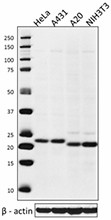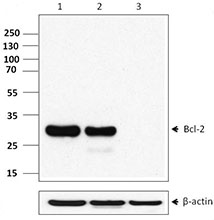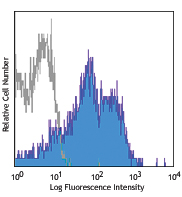- Clone
- W16055A (See other available formats)
- Regulatory Status
- RUO
- Other Names
- Bcl2-associated agonist of cell death, Bcl-2-binding component 6 (Bbc6), Bcl-xL/Bcl-2-associated death promoter, Bcl2 antagonist of cell death.
- Isotype
- Rat IgG2a, κ
- Ave. Rating
- Submit a Review
- Product Citations
- publications

-

Total cell lysates (15 µg protein) from HeLa, A431, A20 and NIH3T3 were resolved by 4-12% Bis-tris gel electrophoresis, transferred to nitrocellulose, and probed with 5 µg/mL purified anti-BAD (clone W16055A) antibody. Proteins were visualized using an HRP goat anti-rat-IgG secondary antibody (clone Poly4054) and chemiluminescence detection. Direct-Blot™ HRP anti-β-actin (clone 2F1-1) antibody was used as a loading control.
| Cat # | Size | Price | Quantity Check Availability | Save | ||
|---|---|---|---|---|---|---|
| 695502 | 100 µg | £189 | ||||
BCL-2 associated agonist of cell death (BAD) is a member of the BCL-2 family, which is involved in the regulation of the mitochondrial apoptosis pathway. The BCL-2 protein family members can either promote cell survival (BCL-2, BCL-XL, and MCL-1) or induce apoptosis (BAX, BAK, BIM, BID, and BAD). The BCL-2 family proteins form homodimers or heterodimers through the conserved BCL-2 homology motifs (BH1, BH2, BH3, and BH4). BAD belongs to the BH3-only proteins and functions as a direct antagonist of the prosurvival effect mediated by BCL-2 and BCL-XL. BAD is inactivated by several survival kinases, such as AKT, PKA, and RSK, through phosphorylation. Upon stimulation of survival signals, phosphorylated BAD dissociates from BCL-2/ BCL-XL complexes and is sequestered in the cytoplasm by 14-3-3 scaffold proteins. Without interacting with BAD, BCL-2 and BCL-XL are able to suppress apoptosis by preventing release of cytochrome c from mitochondria and blocking subsequent activation of caspases.
Product DetailsProduct Details
- Verified Reactivity
- Human, Mouse
- Antibody Type
- Monoclonal
- Host Species
- Rat
- Immunogen
- Full length mouse BAD recombinant protein expressed in E. coli.
- Formulation
- Phosphate-buffered solution, pH 7.2, containing 0.09% sodium azide.
- Preparation
- The antibody was purified by affinity chromatography.
- Concentration
- 0.5 mg/ml
- Storage & Handling
- The antibody solution should be stored undiluted between 2°C and 8°C.
- Application
-
WB - Quality tested
- Recommended Usage
-
Each lot of this antibody is quality control tested by Western blotting. For Western blotting, the suggested use of this reagent is 1.0 - 5.0 µg per ml. It is recommended that the reagent be titrated for optimal performance for each application.
- Product Citations
-
- RRID
-
AB_2650854 (BioLegend Cat. No. 695502)
Antigen Details
- Structure
- 204 amino acids with a predicted molecular weight of 22.1 kD. Contains a BH3 domain responsible for dimer formation.
- Distribution
-
Mitochondrion outer membrane and cytoplasm.
- Function
- BAD is a proapoptotic protein, promoting cell apoptosis through inactivating the BCL-2 family members BCL-2 and BCL-XL.
- Interaction
- Forms homodimers or heterodimers with other members of the same family. Interacts with S100A10, 14-3-3, AKT1, PIM3, NOL3, and HIF3A.
- Biology Area
- Apoptosis/Tumor Suppressors/Cell Death, Cell Biology
- Antigen References
-
1. Cekanova M, et al. 2015. Exp. Cell. Res. 331:1.
2. Pareja F, et al. 2014. Mol. Cancer Res. 12:987.
3. Sakamaki J, et al. 2011. Proc. Natl. Acad. Sci. USA 108:6085.
4. Yu C, et al. 2004. Mol. Cell. 13:329-40.
5. Cartier A, et al. 2003. Exp. Cell Res. 291:242.
6. Moriishi K, et al. 2002. Virology 292:258. - Gene ID
- 12015 View all products for this Gene ID
- UniProt
- View information about BAD on UniProt.org
Other Formats
View All BAD Reagents Request Custom Conjugation| Description | Clone | Applications |
|---|---|---|
| Purified anti-BAD | W16055A | WB |
Customers Also Purchased




Compare Data Across All Formats
This data display is provided for general comparisons between formats.
Your actual data may vary due to variations in samples, target cells, instruments and their settings, staining conditions, and other factors.
If you need assistance with selecting the best format contact our expert technical support team.
-
Purified anti-BAD

Total cell lysates (15 µg protein) from HeLa, A431, A20 and ...
 Login / Register
Login / Register 







Follow Us